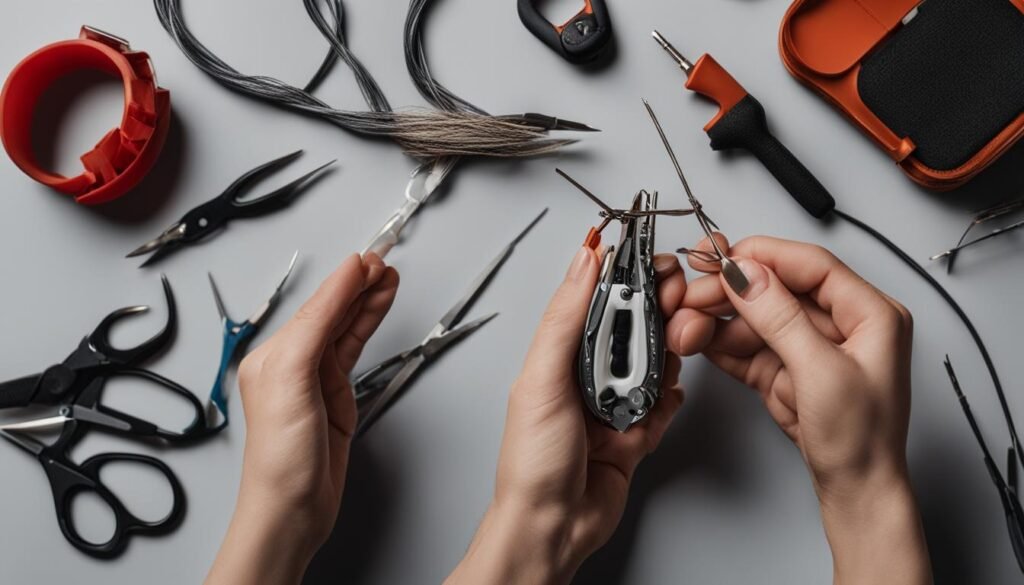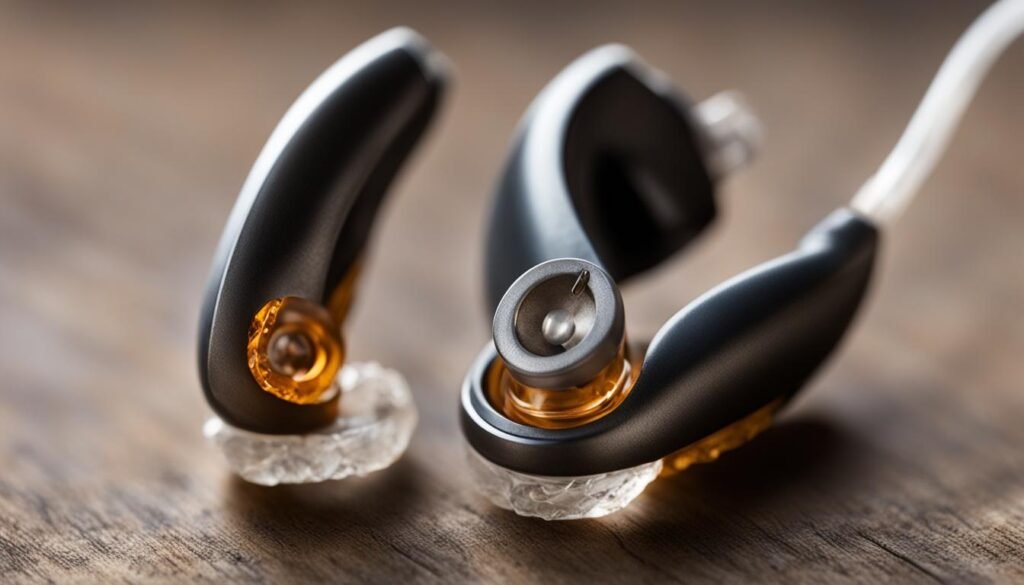“Why Does My Hearing Aid Keep Cutting Out?” Hearing aids are invaluable for improving the quality of life of those with hearing loss, yet they’re not impervious to problems. The frustration of a hearing aid intermittently cutting out, resulting in inconsistent sound and communication challenges, is a common concern. Comprehending the reasons behind these interruptions is vital to discovering effective solutions.
There are several common reasons your hearing aid may stop working or cut out unexpectedly. These include:
- Plugged wax guards, which can distort sound and block the speaker
- Frayed or damaged receiver wires affect the functionality of the aid
- Cracked or brittle BTE (behind-the-ear) tubing, causing disruptions in sound transmission
- Bluetooth connectivity issues leading to audio interruptions
- Clogged microphone ports, resulting in sound distortion
- Moisture exposure, which can damage the internal components
Addressing these issues and taking preventive measures can ensure clear and consistent sound from your hearing aids. In the following sections, we will explore these causes in more detail and provide practical tips to overcome them.
Key Takeaways:
- Plugged wax guards can disrupt sound quality, so regularly replace them to avoid issues
- Handling your hearing aids gently can prevent frayed or damaged receiver wires
- Check BTE tubing for cracks and plan for regular replacements to maintain optimal functionality
- Troubleshoot Bluetooth connectivity problems and clean microphone ports regularly
- Take precautions to prevent moisture exposure, such as using a hearing aid dryer or dehumidifier
Common Hearing Aid Issues: Plugged Wax Guards
One common reason hearing aids stop working is when the wax guard becomes plugged. The wax guard is designed to protect the speaker from wax in the ear, but it can become clogged over time and distort the sound. Regularly replacing the wax guards, typically once a month, can help prevent this issue. Wax guards are usually included with hearing aids and can be purchased separately.
Does Cortexi really work for tinnitus? Explore our expertly crafted article on ‘does Cortexi really work for tinnitus’, where we critically evaluate this treatment’s effectiveness.
If you notice that your hearing aid is producing distorted or muffled sounds, it could be a sign that the wax guard needs to be replaced. This is a simple fix that you can do at home. Gently remove the old wax guard using the provided tool or a soft brush, then insert a new one. Ensure that the guard is aligned correctly and securely in position. By maintaining clean and clear wax guards, you can enjoy optimal sound quality from your hearing aids.
Steps to Replace Wax Guards:
- Remove the old wax guard using the provided tool or a soft brush.
- Insert a new wax guard in its place, ensuring it is appropriately aligned.
- Ensure that the wax guard is securely in position.
“Regularly replacing the wax guards, typically once a month, can help prevent distorted sound from hearing aids.”
In addition to replacing the wax guards, it is essential to clean your hearing aids regularly to prevent wax buildup. Follow the manufacturer’s instructions on how to clean your specific hearing aids, and avoid using any harsh chemicals or liquids. Remember to remove your hearing aids before showering or swimming to prevent moisture from entering the device. By taking these preventative measures, you can prolong the lifespan of your hearing aids and maintain optimal performance.
Common Hearing Aid Issues: Frayed or Damaged Receiver Wires
If you have a receiver-in-canal (RIC) hearing aid, one common issue to be aware of is frayed or damaged receiver wires. These tiny wires connect the main body of the hearing aid to the receiver, which sits in the ear canal. Over time, these wires can become strained, bent, or even cut, leading to problems with the functioning of the hearing aid.

To prevent wire damage, it’s crucial to handle your hearing aids with care. Avoid pulling on the wire forcefully when removing your hearing aids. Instead, gently hold the tip or earmold in your ear and pull them out slowly. This gentle handling technique can help safeguard the receiver wires from unnecessary strain or damage.
Can shingles cause hearing loss? Read More
If the receiver wire does break while your hearing aid is still under warranty, don’t panic. Most hearing care professionals can replace the damaged wire at no additional cost. Schedule an appointment with your provider, who will take care of the necessary repair or replacement. Remember to contact them promptly to ensure your hearing aids are functioning optimally.
Pro Tip:
Regularly inspect your hearing aids for any signs of wear or damage, especially the receiver wires. Check for any fraying, discoloration, or visible cuts. If you notice any issues, contact your hearing care professional to address them promptly. Taking proactive steps to prevent wire damage can prolong the lifespan of your hearing aids and ensure continuous, clear sound.
Common Hearing Aid Issues: Cracked or Brittle BTE Tubing
If you have a behind-the-ear (BTE) hearing aid, it’s essential to be aware of one common issue that may arise: cracked or brittle tubing. The tubing that connects the hearing aid to the earmold can become damaged over time due to wear and tear or exposure to moisture. Regular checks for cracks or damage in the tubing are recommended to ensure optimal performance.
Regular tubing changes are also essential to maintain the functionality of your BTE hearing aid. Typically, replacing the tubing every six months is advised to prevent potential issues. By adhering to this regular maintenance schedule, you can ensure that your hearing aid continues to provide you with clear and consistent sound.

If you notice any problems with the tubing, such as cracks or tears, it is recommended that you visit your hearing care professional for a tubing change. They will be able to assess the condition of the tubing and replace it if necessary, ensuring that your hearing aid functions appropriately.
By staying proactive in checking for cracks and regularly replacing the tubing, you can prevent potential issues with your BTE hearing aid. Remember, ensuring the proper care and maintenance of your hearing aids is crucial for optimal performance and enjoying their benefits.
Common Hearing Aid Issues: Bluetooth Connectivity and Other Problems
Bluetooth connectivity issues can sometimes arise with hearing aids that have this feature. If you’re experiencing problems connecting your hearing aids to other devices via Bluetooth, you can try a few troubleshooting steps.
First, make sure that your hearing aids are turned on and that Bluetooth is enabled on your phone or other device. Check if your hearing aids appear in the Bluetooth menu. If they don’t, try restarting your hearing aid and device. This can often resolve connectivity issues.
In addition to Bluetooth problems, another common issue is clogged microphone ports. Over time, debris and wax can accumulate in the microphone ports, affecting the sound quality of your hearing aids. To clean the microphone ports, gently brush them with a soft-bristled toothbrush. This will help maintain a clear and consistent sound.
Read Also: Why Do My Hearing Aids Whistle
Moisture exposure can also lead to various problems with hearing aids. To prevent moisture-related issues, consider using a hearing aid dryer or dehumidifier. These devices can help remove excess moisture and keep your hearing aids dry and functioning correctly. Another option is to place a pack of desiccant beads in your hearing aid charging case, as they absorb moisture effectively.
Frequently Asked Questions
Why does my hearing aid keep cutting out?
There can be several reasons why your hearing aid may cut out. Some common causes include plugged wax guards, frayed or damaged receiver wires, cracked or brittle BTE tubing, Bluetooth connectivity issues, clogged microphone ports, and moisture exposure.
How do I fix plugged wax guards?
Regularly replacing the wax guards, typically once a month, can help prevent this issue. Wax guards are usually included with hearing aids and can be purchased separately.
What should I do if I have frayed or damaged receiver wires?
To prevent wire damage, it’s essential to handle your hearing aids with care and avoid pulling on the wire forcefully. If the receiver wire breaks while under warranty, it can usually be replaced by your hearing care professional at no extra charge.
How often should I replace BTE tubing?
It’s essential to regularly check the tubing for any cracks or damage and plan for regular tubing changes, typically every six months. If you notice any problems with the tubing, such as cracks or tears, you should visit your hearing care professional for a tubing change.
What can I do with Bluetooth connectivity issues with my hearing aids?
Troubleshooting steps include:
- Ensuring that your hearing aids are turned on and that Bluetooth is enabled on your phone.
- Confirming that your hearing aids appear in the Bluetooth menu.
- Restarting your hearing aid and device if needed.
How can I prevent moisture-related issues with my hearing aids?
Using a hearing aid dryer dehumidifier or placing a pack of desiccant beads in your charging case can help prevent moisture-related issues.



